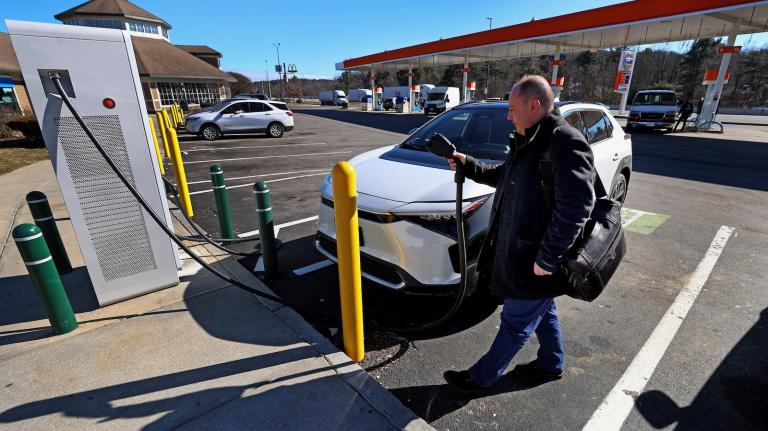
Now that the housing market is tanking, is it a good time to talk about the absurdity of the Home Interest Mortgage Deduction?
I mean, it’s truly crummy social policy. The biggest benefits go to the people in the highest tax brackets, own expensive homes, and earn enough income that they can itemize their deductions. So in essence, the HIMD is a ginormous housing subsidy for the well-off — and one that dwarfs all of the housing subsidies to lower-income folks. This NY Times article lays out the case nicely: apparently, half the benefit of the deduction goes to the 12 percent of taxpayers who make at least $100 grand per year.
But the conventional wisdom is that the home interest mortgage deduction isn’t just crummy social policy, but crummy environmental policy as well. Allowing homeowners to deduct mortgage interest on their taxes gives people an incentive spend more of their money on housing than they otherwise would. And people with extra money to spend on housing tend to buy larger homes on bigger lots — which, in theory at least, means that the HIMD primes the pump for low-density sprawl.
But is this really true? Does the HIMD really accelerate low-density sprawl?
Not too long ago, my office — which has long been officially opposed to the HIMD — got an email from a guy who wanted to buy a condo in a neighborhood close to downtown. He just wanted a modest home where he didn’t have to drive much. (In terms of greenhouse-gas emissions, downtown living is about the best you can do, short of ditching your car and going off the grid.)
He argued that, condo prices being what they were, he simply couldn’t afford to buy close to the city center without the HIMD. Take away the interest deduction, and he’s got little choice but to stick with a bigger, more energy-hogging house in the ‘burbs (several of the comments on this thread over at Matthew Yglesias’s house make the same point).
So, which is it? Does the deduction accelerate sprawl, by encouraging homeowners to buy more land than they otherwise would? Or does it temper sprawl, by making homes in expensive, conveniently located neighborhoods more affordable?
I’m not 100% sure — but it may well be that the answer is: neither. And here’s my reasoning, for what it’s worth …
The mortgage interest deduction’s chief effect is to encourage people to spend more on their homes, and less on the things that they otherwise might want to buy. After all, for every $1,000 you spend on mortgage interest, you can get $300 or so back on taxes — which is a deal you don’t get from, say, buying shoes, or going out to dinner.
Of course, there are a bunch of different ways to spend more money on a home. For example, you can buy …
- a bigger yard;
- a home in a more desirable neighborhood (where the definition of "more desirable" is left as an exercise to the reader);
- a more spacious home;
- a nicer home (e.g., fancier, or with better appliances or countertops or whatnot).
At heart, the first two items represent spending on land, and the latter two represent spending on the home itself.
But the thing is this: the supply of land is fixed (or, arguably, declining). So to the extent that the HIMD encourages people to spend more on land — either for bigger lots, or for better locations — home buyers aren’t actually getting anything extra for their money. They’re simply bidding up the price of land.
By now, many decades after the HIMD first went into effect, the tax breaks and higher bids for property have been fully capitalized into land values. If we eliminate the HIMD, sure, people will have less to spend to on large lots, but the land itself will become cheaper. On net, the two forces (less money to spend on land, cheaper land prices) will largely balance out — suggesting that jettisoning the HIMD would have roughly no effect on the affordability of land itself, or on people’s ability to buy big lots on the outskirts of town.
OK, I’d bet dollars-to-donuts that a sophisticated economic analysis (which this sure ain’t) would find holes in this reasoning. I’m sure that canceling the HIMD would have some effect on land affordability. Still, I’d wager that the effects of the HIMD on lot size are much more modest now than when the policy first went into effect — and may be far more modest than I’d previously assumed.
On the other hand, to the extent that people currently use HIMD subsidies to buy bigger, fancier homes (regardless of lot size), the deduction still has a major environmental downside. Larger homes — with cathedral ceilings, bonus rooms, and palatial master suites — consume lots of energy for heating, cooling, and lighting. Which means that even if the HIMD no longer does much to encourage low-density sprawl, it still makes McMansions seem like a good buy.
But, by the same token, high-rise condos are also quite expensive to build, especially measured per square foot of floor space. So the HIMD might also help people cover the construction costs of condo, if that’s their preference — which would decrease average energy consumption. (Gosh, this is getting complicated.)
So let’s review. Getting rid of the HIMD would reduce housing subsidies to the wealthy; reduce the nominal price of land; have little effect on the affordability of land; and eliminate subsidies for expensive home construction, which could reduce both house size (a good thing) and the construction of high-cost condos (for energy efficiency at least, not so good). But on balance — given the market’s preference over the last few decades for big homes over conveniently located ones, I’d bet that maintaining the HIMD would still do more environmental harm than good.
However, perhaps the case for the HIMD being a sprawl-accelerator isn’t as strong as I thought it was. What the HIMD gives in buying power for big suburban lots, it takes away as higher land prices. Net effect on the preference for suburbs over cities: Meh.

